A Bibliometric Analysis of Geological Hazards Monitoring Technologies
Abstract
1. Introduction
2. Data and Methods
3. Results
3.1. Research Status
3.1.1. Trends in Literature Publication
3.1.2. High-Volume Publication Journals
3.2. Main Research Forces
3.2.1. Trends of High-Volume Research Institutions
3.2.2. Activity Index (AI) and Attractive Index (AAI)
3.3. Research Hot Spots and Frontier Analysis
3.3.1. Keyword Co-Occurrence Analysis
3.3.2. Intelligent Geological Hazards Warning Analysis
4. Discussion
4.1. Research Stages
4.2. Research Community
4.3. Research Technologies
4.4. Study Contributions and Limitations
5. Conclusions
Author Contributions
Funding
Institutional Review Board Statement
Informed Consent Statement
Data Availability Statement
Conflicts of Interest
References
- Huang, R.Q.; Li, W.L. Analysis of the geo-hazards triggered by the 12 May 2008 Wenchuan Earthquake, China. Bull. Eng. Geol. Environ. 2009, 68, 363–371. [Google Scholar] [CrossRef]
- Brabb, E.E. The world landslide problem. Episodes 1991, 14, 52–61. [Google Scholar] [CrossRef]
- Froude, M.J.; Petley, D.N. Global fatal landslide occurrence from 2004 to 2016. Nat. Hazards Earth Syst. Sci. 2018, 18, 2161–2181. [Google Scholar] [CrossRef]
- Zhang, C.S.; Zhang, Y.C.; Hu, J.J.; Gao, Q.Z. Spatial and temporal distribution characteristics and forming conditions of Chinese geological disasters. Quat. Sci. 2000, 20, 559–566. [Google Scholar] [CrossRef]
- Dowling, C.A.; Santi, P.M. Debris flows and their toll on human life: A global analysis of debris-flow fatalities from 1950 to 2011. Nat. Hazards 2014, 71, 203–227. [Google Scholar] [CrossRef]
- Andersson-Sköld, Y.; Bergman, R.; Johansson, M.; Persson, E.; Nyberg, L. Landslide risk management-a brief overview and example from Sweden of current situation and climate change. Int. J. Disaster Risk Reduct. 2012, 3, 44–61. [Google Scholar] [CrossRef]
- Tie, Y.B.; Zhang, X.Z.; Gong, L.F.; Gao, Y.C.; Bai, Y.J.; Xu, W.; Ba, R.J.; Li, Z.L.; Ge, H. Research on the pattern of typical geohazard chains in the southwest mountainous region, China. J. Geomech. 2022, 28, 1071–1080. [Google Scholar] [CrossRef]
- Kyle, B.; Rishav, M.; Harisma, A.; Judith, H.; Ella, M.; Adam, S.; Nairong, D.; Gilles, B.; Dedy, A.; Benazir, B.; et al. Earthquake-triggered 2018 Palu Valley landslides enabled by wet rice cultivation. Nat. Geosci. 2019, 12, 935–939. [Google Scholar] [CrossRef]
- Aerts, J.C.J.H.; Botzen, W.J.; Clarke, K.C.; Cutter, S.L.; Hall, J.W.; Merz, B.; Michel-Kerjan, E.; Mysiak, J.; Surminski, S.; Kunreuther, H. Integrating human behaviour dynamics into flood disaster risk assessment. Nat. Clim. Change 2018, 8, 193–199. [Google Scholar] [CrossRef]
- Jiménez-Perálvarez, J.D.; Irigaray, C.; El Hamdouni, R.; Chacón, J. Building models for automatic landslide-susceptibility analysis, mapping and validation in ArcGIS. Nat. Hazards 2009, 50, 571–590. [Google Scholar] [CrossRef]
- Yang, F.; Jiang, Z.R.; Ren, J.Q.; Lyv, J. Monitoring, Prediction, and Evaluation of Mountain Geological Hazards Based on InSAR Technology. Sci. Program. 2022, 2022, 2227049.1–2227049.12. [Google Scholar] [CrossRef]
- Nichol, J.E.; Shaker, A.; Wong, M.S. Application of high-resolution stereo satellite images to detailed landslide hazard assessment. Geomorphology 2006, 76, 68–75. [Google Scholar] [CrossRef]
- Kulawardhana, R.W. Remote sensing and GIS technologies for monitoring and prediction of disasters. Int. J. Digit. Earth 2012, 5, 88–90. [Google Scholar] [CrossRef]
- Qian, C. Landslide Recognition Based on Machine Learning Considering Terrain Feature Fusion. ISPRS Int. J. Geo-Inf. 2024, 13, 306. [Google Scholar] [CrossRef]
- Qin, H.; Wang, J.; Mao, X.; Zhao, Z.; Gao, X.; Lu, W. An Improved Faster R-CNN Method for Landslide Detection in Remote Sensing Images. J. Geovis. Spat. Anal. 2024, 8, 2. [Google Scholar] [CrossRef]
- Prokesova, R.; Kardos, M.; Taborik, P.; Medved’ova, A.; Stacke, V.; Chudy, F. Kinematic behaviour of a large earthflow defined by surface displacement monitoring, DEM differencing, and ERT imaging. Geomorphology 2014, 224, 86–101. [Google Scholar] [CrossRef]
- Joyce, K.E.; Samsonov, S.V.; Levick, S.R.; Engelbrecht, J.; Belliss, S. Mapping and monitoring geological hazards using optical, LiDAR, and synthetic aperture RADAR image data. Nat. Hazards 2014, 73, 137–163. [Google Scholar] [CrossRef]
- Xu, Q. Understanding the landslide monitoring and early warning: Consideration to practical issues. J. Eng. Geol. 2020, 28, 360–374. [Google Scholar] [CrossRef]
- Ingrid, A.B.G.; Renato, M.; Jorge, R.; Chris, G.; Roger, S.; Kristen, T. Introduction and testing of a cost-effective GNSS system for landslide monitoring. Nat. Hazards 2014, 120, 8521–8549. [Google Scholar] [CrossRef]
- Xu, Q. Understanding and consideration of related issues in early identification of potential geohazards. Geomat. Inf. Sci. Wuhan Univ. 2020, 45, 1651–1659. [Google Scholar] [CrossRef]
- Van Eck, N.J.; Waltman, L. Citation-based clustering of publications using CitNetExplorer and VOSviewer. Scientometrics 2017, 111, 1053–1070. [Google Scholar] [CrossRef] [PubMed]
- Jamil, A.; Ahmad, A.; Irfan, M.; Hou, X.; Wang, Y.; Chen, Z.; Liu, X. Global microplastics pollution: A bibliometric analysis and review on research trends and hotspots in agroecosystems. Environ. Geochem. Health 2024, 46, 486. [Google Scholar] [CrossRef] [PubMed]
- Petrović, E.K.; Thomas, C.A. Global Patterns in Construction and Demolition Waste (C&DW) Research: A Bibliometric Analysis Using VOSviewer. Sustainability 2024, 16, 1561. [Google Scholar] [CrossRef]
- Lyu, Y.J.; Zhao, H.J.; Zeng, G.P.; Yang, J.; Shao, Q.P.; Wu, H.Y. Mapping the evolving trend of research on leukocyte telomere length: A text-mining study. Hum. Genom. 2024, 18, 117. [Google Scholar] [CrossRef]
- Kemeç, A.; Altınay, A.T. Sustainable Energy Research Trend: A Bibliometric Analysis Using VOSviewer, RStudio Bibliometrix, and CiteSpace Software Tools. Sustainability 2023, 15, 3618. [Google Scholar] [CrossRef]
- Salmerón-Manzano, E.; Manzano-Agugliaro, F. Bibliometric Studies and Worldwide Research Trends on Global Health. Int. J. Environ. Res. Public Health 2024, 17, 5748. [Google Scholar] [CrossRef]
- Ji, W.; Yu, S.; Shen, Z.; Wang, M.; Cheng, G.; Yang, T.; Yuan, Q. Knowledge Mapping with CiteSpace, VOSviewer, and SciMAT on Intelligent Connected Vehicles: Road Safety Issue. Sustainability 2023, 15, 12003. [Google Scholar] [CrossRef]
- Shen, S.; Cheng, C.X.; Yang, J.; Yang, S.L. Visualized analysis of developing trends and hot topics in natural disaster research. PLoS ONE 2018, 13, E0191250. [Google Scholar] [CrossRef]
- van Eck, N.J.; Waltman, L. Software survey: VOSviewer, a computer program for bibliometric mapping. Scientometrics 2010, 84, 523–538. [Google Scholar] [CrossRef] [PubMed]
- Cheng, G.; Wang, Z.X.; Li, G.Q.; Ni, Y.F.; Xu, L. Visual analysis of bibliometric research on landslide monitoring in China. China Saf. Sci. J. 2022, 32, 172–179. [Google Scholar] [CrossRef]
- Yan, K.; Chen, H.M.; Fu, D.J.; Zeng, Y.L.; Dong, J.W.; Li, S.W.; Wu, Q.S.; Li, H.L.; Du, S.Y. Bibliometric visualization analysis related to remote sensing cloud computing platforms. Natl. Remote Sens. Bull. 2022, 26, 310–323. [Google Scholar] [CrossRef]

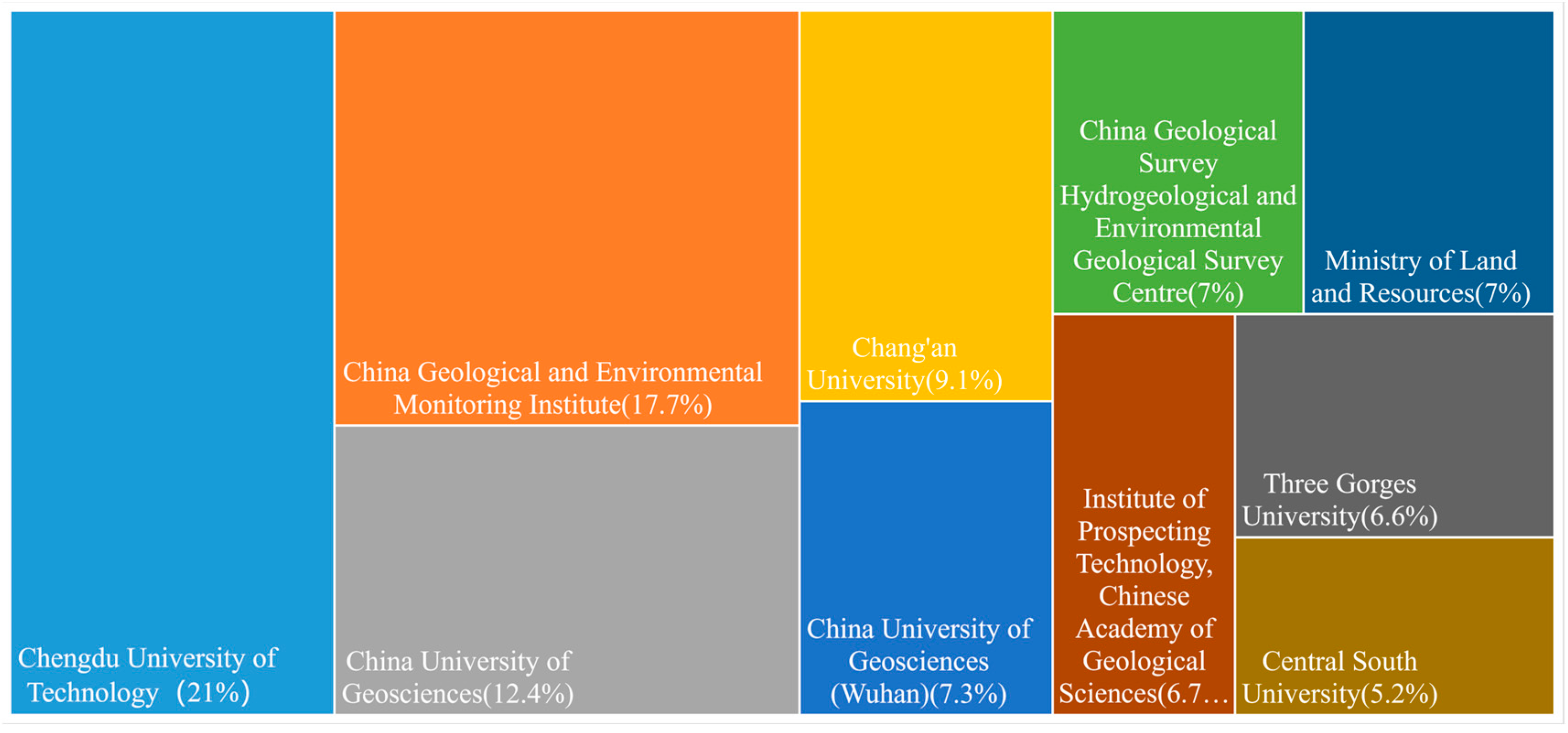
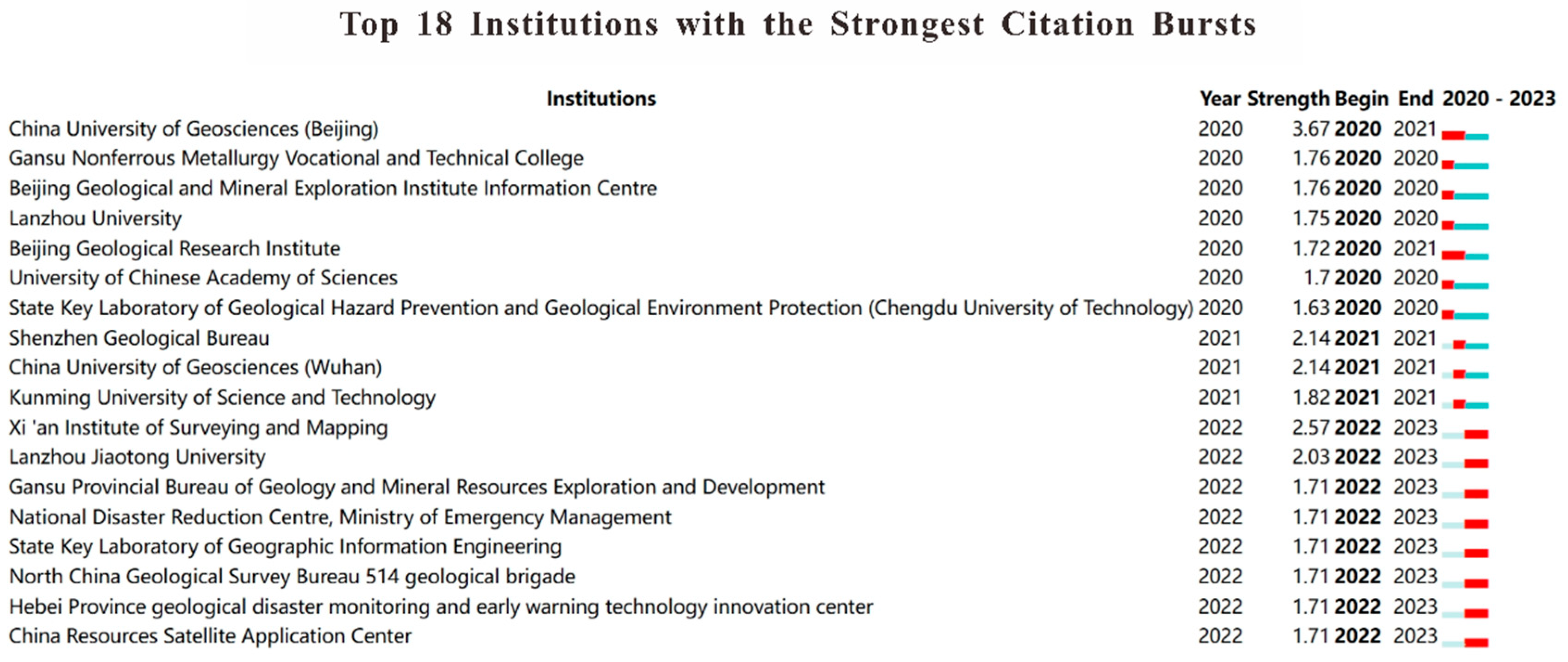
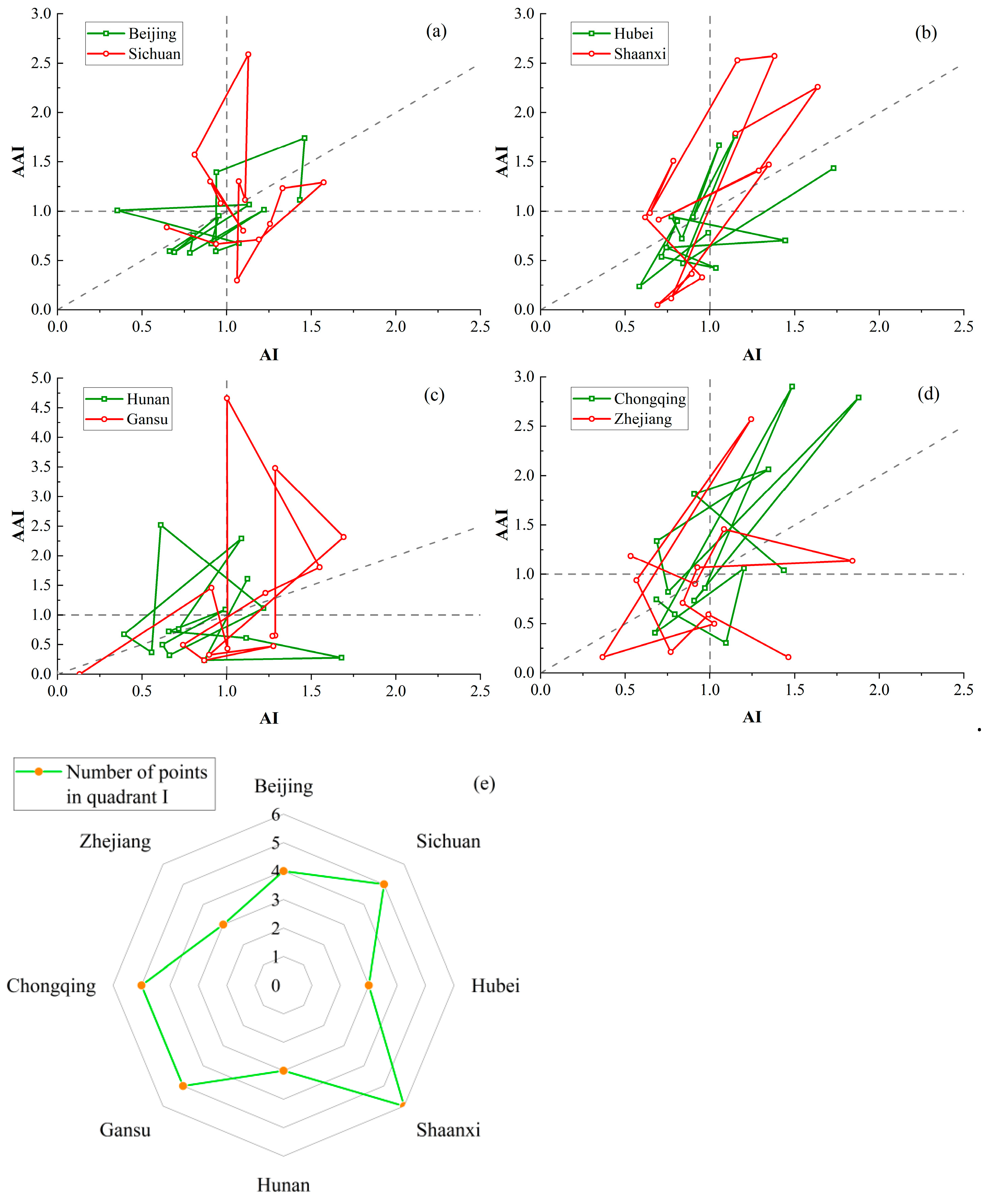
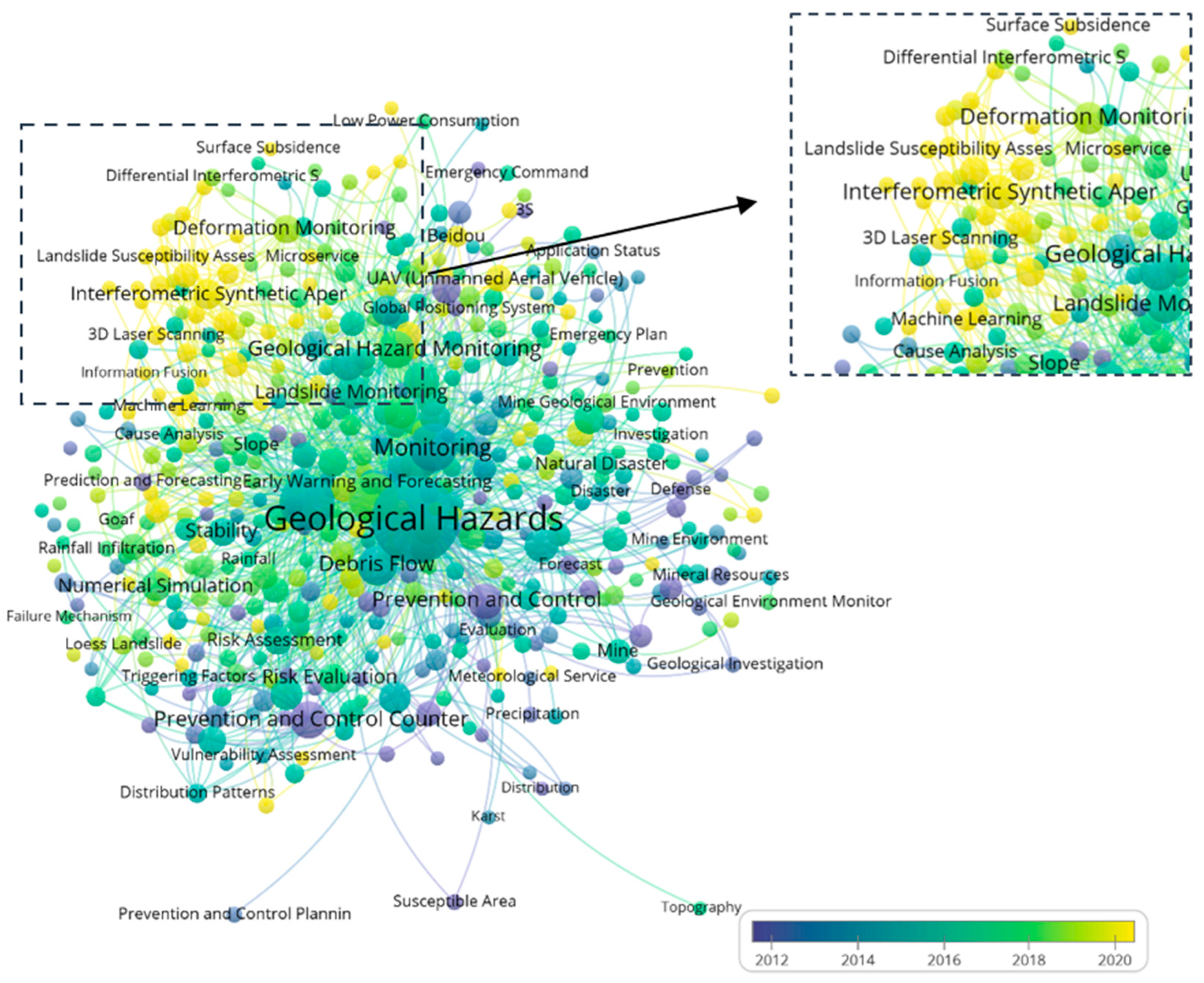
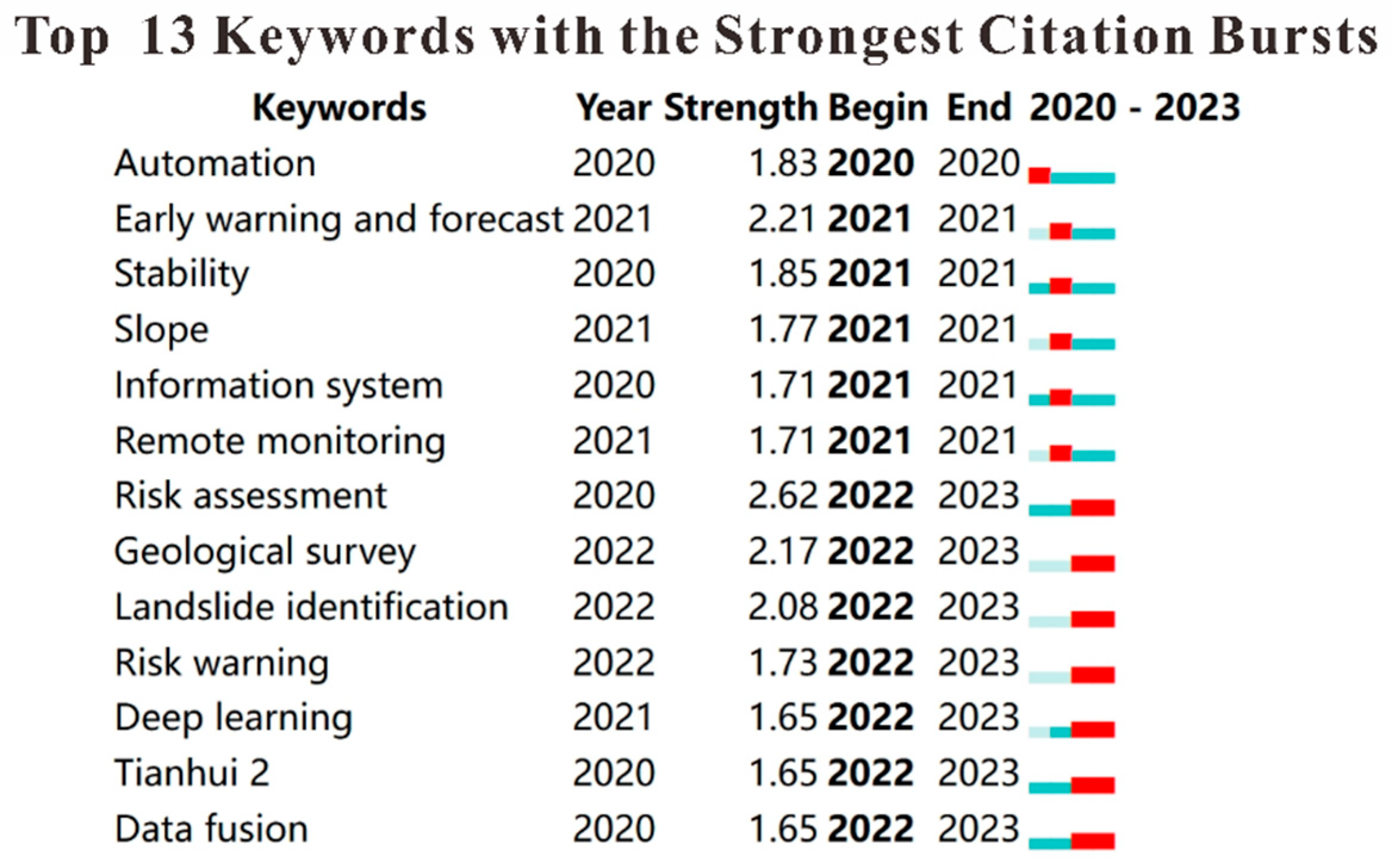

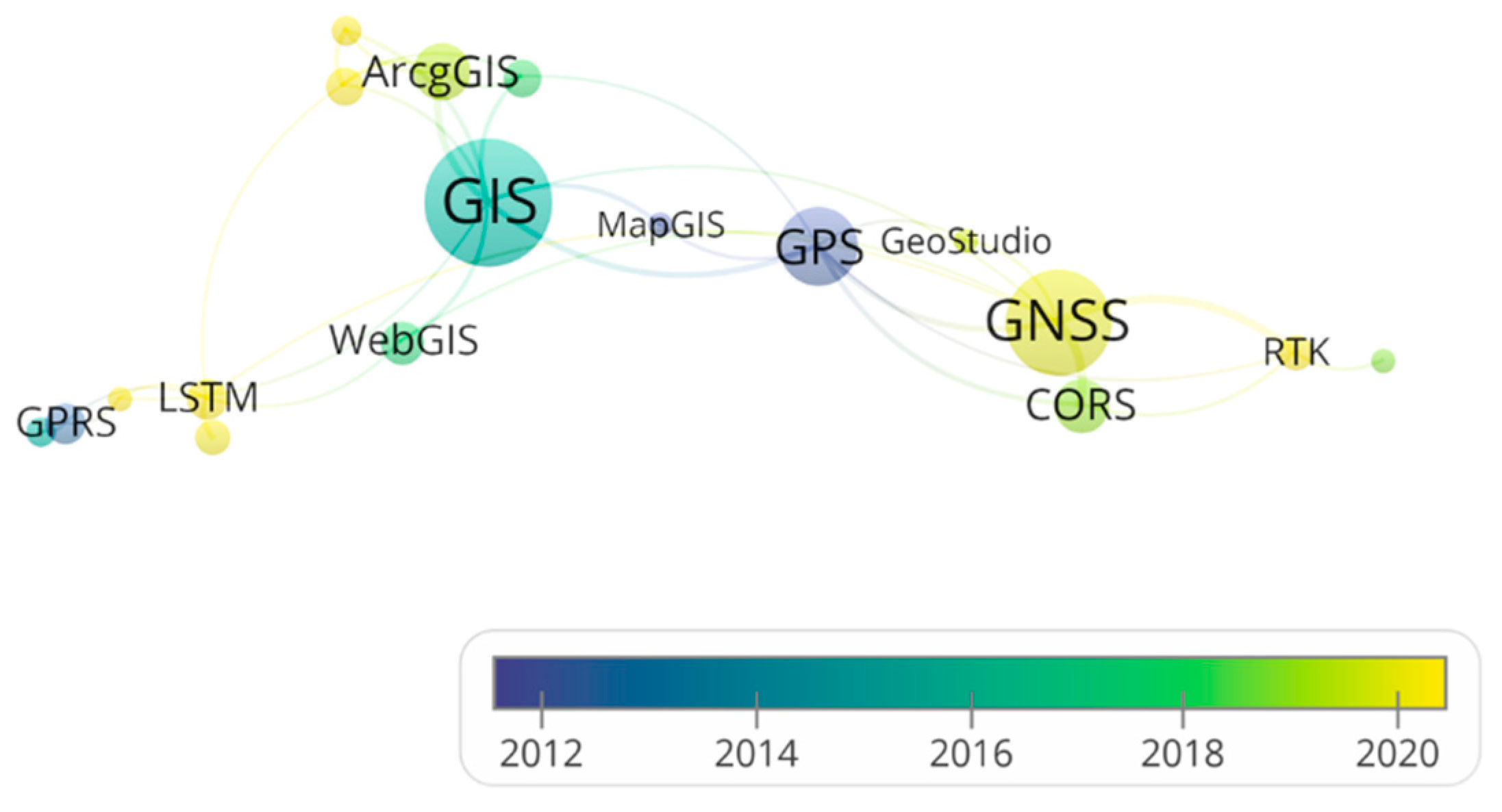
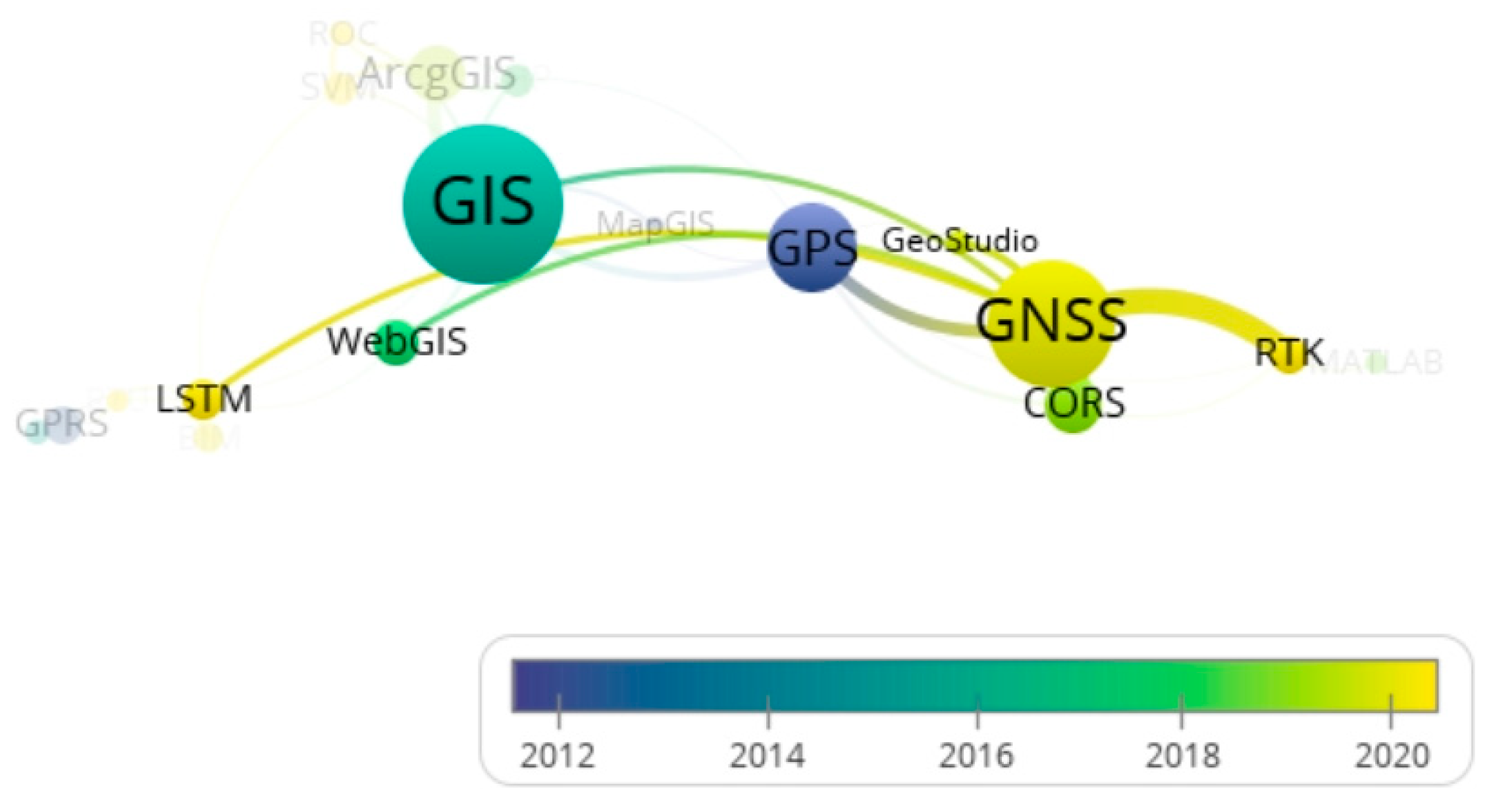
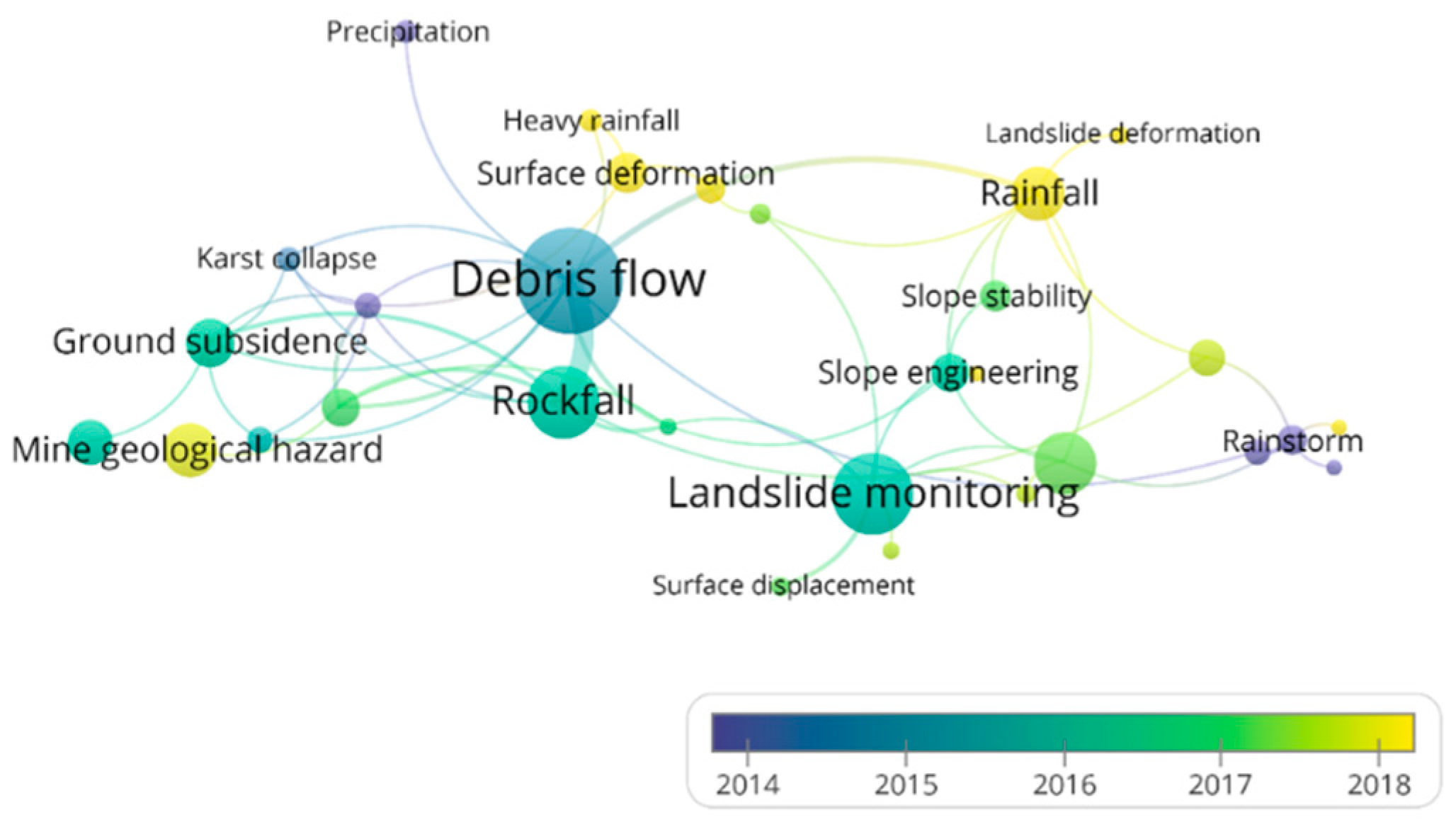
| Classification | Description | Results | Total |
|---|---|---|---|
| CNKI | SU% = ‘Geological hazard monitoring’ OR FT = ‘Geological monitoring hazard monitoring equipment’ + ‘Geological hazards monitoring instruments’ OR FT = ‘Geological hazard monitoring early warning’ + ‘Geological hazard monitoring forecasting’ | Journals and theses: 6490 | 9200 |
| Patents: 1986 | |||
| Books: 41 | |||
| Standards: 1 | |||
| Research outputs: 258 | |||
| Conferences: 424 | |||
| WOS | TS = (Geological Hazard$ Monitoring OR Geological Hazard$ Monitoring and Warning OR Geological Hazard$ Monitoring and Forecasting) | Articles: 1968 | 2923 |
| Meetings: 535 | |||
| Review Articles: 81 | |||
| Dissertation Theses: 148 | |||
| Awarded Grants: 176 | |||
| Book: 15 |
| Rank | Journal | Number of Publications | Percentage of Total Publications/% | Total Cited Times | Average Cited Times |
|---|---|---|---|---|---|
| 1 | The Chinese Journal of Geological Hazard and Control | 207 | 4.24 | 3371 | 15.9 |
| 2 | Chengdu University of Technology | 180 | 2.77 | 2726 | 15.14 |
| 3 | China University of Geosciences (Beijing) | 122 | 1.88 | 1041 | 8.53 |
| 4 | Chang’an University | 104 | 1.60 | 1119 | 10.76 |
| 5 | World Nonferrous Metals | 102 | 2.09 | 220 | 2.16 |
| 6 | National Land & Resources Information | 97 | 1.99 | 118 | 1.22 |
| 7 | Zhejiang Land & Resources | 94 | 1.93 | 29 | 0.31 |
| 8 | Nanfang Ziran Ziyuan | 80 | 1.64 | 83 | 0.92 |
| 9 | Urban Geology | 67 | 1.37 | 395 | 5.90 |
| 10 | Hydrogeology & Engineering Geology | 65 | 1.33 | 1349 | 20.75 |
| S/N | Keywords | Occurrences |
|---|---|---|
| 1 | Geological Hazards | 2602 |
| 2 | Landslide | 772 |
| 3 | Monitoring and Early Warning | 505 |
| 4 | Monitoring | 483 |
| 5 | Debris Flow | 233 |
| 6 | Geological Hazard Monitoring | 202 |
| 7 | Prevention and Mitigation Measures | 196 |
| 8 | Prevention | 194 |
| 9 | Geological Environment | 171 |
| 10 | Landslide Monitoring | 151 |
Disclaimer/Publisher’s Note: The statements, opinions and data contained in all publications are solely those of the individual author(s) and contributor(s) and not of MDPI and/or the editor(s). MDPI and/or the editor(s) disclaim responsibility for any injury to people or property resulting from any ideas, methods, instructions or products referred to in the content. |
© 2025 by the authors. Licensee MDPI, Basel, Switzerland. This article is an open access article distributed under the terms and conditions of the Creative Commons Attribution (CC BY) license (https://creativecommons.org/licenses/by/4.0/).
Share and Cite
Liu, Z.; Huang, J.; Li, Y.; Liu, X.; Qiang, F.; He, Y. A Bibliometric Analysis of Geological Hazards Monitoring Technologies. Sustainability 2025, 17, 962. https://doi.org/10.3390/su17030962
Liu Z, Huang J, Li Y, Liu X, Qiang F, He Y. A Bibliometric Analysis of Geological Hazards Monitoring Technologies. Sustainability. 2025; 17(3):962. https://doi.org/10.3390/su17030962
Chicago/Turabian StyleLiu, Zhengyao, Jing Huang, Yonghong Li, Xiaokang Liu, Fei Qiang, and Yiping He. 2025. "A Bibliometric Analysis of Geological Hazards Monitoring Technologies" Sustainability 17, no. 3: 962. https://doi.org/10.3390/su17030962
APA StyleLiu, Z., Huang, J., Li, Y., Liu, X., Qiang, F., & He, Y. (2025). A Bibliometric Analysis of Geological Hazards Monitoring Technologies. Sustainability, 17(3), 962. https://doi.org/10.3390/su17030962






